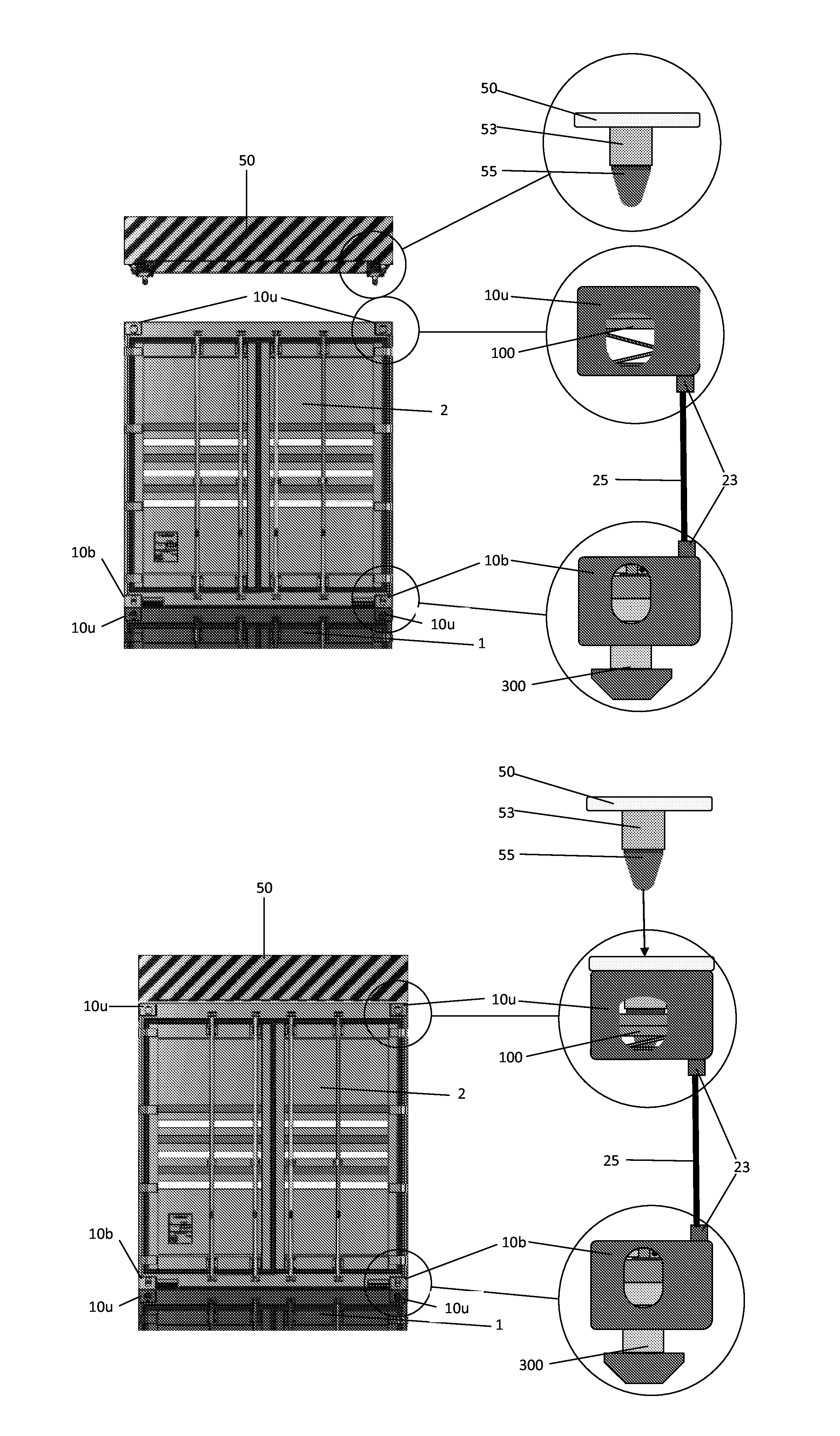Although these devices and systems are currently used to connect containers to various bases, they possess a number of disadvantages that make them unsafe and inefficient.
Cones require manual locking and unlocking, incurring additional labor costs and placing humans in potentially dangerous situations.
Additionally, they require personnel to work both on vessels and on the ground, again increasing labor costs.
In addition, when cones are not inserted or turned into the locking position, they can become detached from a container causing additional problems, such as an unsecured connection between a container and a base or, when being hoisted by a lifting device, the cone can fall from the container, injuring or killing personnel.
Further, a cone is one form of a number of similar locking devices used to secure containers, such that additional equipment and additional purchase and maintenance costs are incurred.
Lastly, recent U.S. regulations have required that all cones used at U.S. ports be of the automatic type due to safety considerations, causing the manual cones to be unsuitable for use in the U.S.
Although automatic cones eliminate the need to manually lock containers to a base, they still require a manual release, still placing personnel into dangerous work environments.
Furthermore, automatic cones have a number of the disadvantages that manual cones possess, including: requiring personnel to work both on vessels and on the ground, the cones can fall free injuring or killing personnel below, and an automatic cone is one form of a number of similar locking devices used to secure containers such that additional equipment and therefore additional purchase and maintenance costs are incurred.
Although twistlocks address some of the limitations of the previous devices, they also possess a number of disadvantages.
The manual requirement can put a person in a dangerous work environment where heavy machinery is lifting tons of equipment, thereby putting an individual at risk of injury or death.
A second
disadvantage of twistlocks is the resulting procedures that are adopted to prevent personnel from having to unlock containers from their bases in dangerous environments.
This method can create a number of dangerous situations in a
yard.
First, the container is no longer connected to the
chassis, it is merely resting on the
chassis.
If an accident were to occur, the container is not connected to chassis, causing an unpredictable and potentially dangerous situation.
Additionally, while driving around a
yard, the twistlocks often turn accidentally into the locked position requiring the driver to exit the safety of his vehicle to reopen the twistlock, thereby defeating the goal of the procedure.
These are dangerous situations for drivers and anyone else that might be in the area.
A third
disadvantage is that a twistlock is again one form of a number of similar locking devices used to secure containers such that additional equipment and therefore additional purchase and maintenance costs are incurred.
Another
disadvantage of current methods of securing containers to transport
modes relates to the rail industry.
This is because there is no way to access the lower corner fittings of a container that is sitting in the well of the rail car.
As a result, there is no way to manually unlock a manual or automatic cone or twistlock.
An additional disadvantage of these devises is the number of different locking devices utilized to perform a single function, connecting or disconnecting container from a base.
Another disadvantage of these devices is that they adversely affect crane cycle times by 15 to 20% during vessel loading and discharging operations.
Inventions have been developed to overcome the above mentioned problems including Del Aqua's in 1982 (U.S. Pat. No. 4,341,495) and Cain's in 1976 (U.S. Pat. No. 3,980,185) These forms however were not commercially viable; because the components of the inventions are intrusive into the
interior space of a container, susceptible to being damaged by equipment or cargo moving into and out of containers, and would require modifications to the
doors of a container.
Also, these inventions require all four upper corner castings of a container to be engaged by rotatable twistlocks of a spreader which is not possible when using machines which only engage two of the upper corner castings or at sites that use fork lifts to lift containers.
Lastly, the number of
moving parts that comprise these forms would be difficult and expensive to maintain in a fleet of containers spread around the world.
One problem is caused by the non-standardized geometry of spreader and container securing twistlocks used to hoist and or connect containers together on ships.
Another problem relates to the non-standardized depth penetration of spreader twistlocks housings as they enter a containers corner fitting to hoist it.
Additionally, equipment costs are prohibitive; cones are provided by vessels, not stevedoring companies or container yards.
The additional labor required to set, lock and unlock connecting devices is also costly.
There are hazards inherent by not connecting the containers together while in a stacked configuration, such as building a disorderly
pile.
While one container is being added to a stack of containers, the container being stacked may nudge another container in the stack, causing it to fall.
For obvious reasons, this is an extremely undesirable and dangerous situation, potentially causing great damage and injury.
As can be seen by existing solution attempts, the problem of providing a safe, economical, universal, and automatic means to secure containers has not been fully addressed.
Existing methods can require placing humans in dangerous situations, require many costly parts, require manual locking and unlocking, and create disorderly piles.
 Login to View More
Login to View More  Login to View More
Login to View More 


